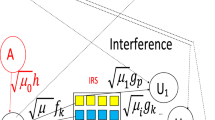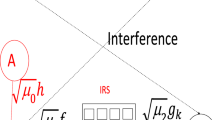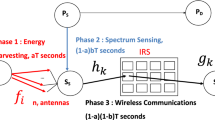Abstract
In this paper, we propose the use of Intelligent Reflecting Surfaces (IRS) between the secondary source and K secondary users. The secondary source transmits the combination of K symbols dedicated to K secondary Non Orthogonal Multiple Access (NOMA) users. A set \(I_i\) of IRS reflectors are dedicated to user \(U_i\) so that all reflections are in phase at \(U_i\). We derive the throughput when the secondary source harvests energy using \(n_r\) antennas and transmits with an adaptive transmit power to generate low interference at primary destination. We show that the use of IRS with 32 reflectors per user offers up to 45 and 50 dB gain with respect to NOMA and Orthogonal Multiple Access (OMA) without IRS.










Similar content being viewed by others
Data availibility
Material and data are not available.
References
Basar, E., Renzo, M. D., Rosny, J. D., Debbah, M., Alouini, M.-S., & Zhang, R. (2019). Wireless communications through reconfigurable intelligent surfaces. IEEE Access, 7, 142.
Zhang, H., Di, Boya, Lingyang, S., & Han, Z. (2020). Reconfigurable intelligent surfaces assisted communications with limited phase shifts: how many phase shifts are enough? IEEE Transactions on Vehicular Technology, 69, 4.
Renzo, MD. (2019). “6G Wireless: Wireless Networks Empowered by Reconfigurable Intelligent Surfaces”, 2019 25th Asia-Pacific Conference on Communications (APCC).
Basar, E. (2020). reconfigurable intelligent surface-based index modulation: a new beyond MIMO paradigm for 6G. Early Access Article: IEEE Transactions on Communications, 68, 3187.
Wu, Q., & Zhang, R. (2020). Towards smart and reconfigurable environment: intelligent reflecting surface aided wireless network. IEEE Communications Magazine, 58(1), 106–112. https://doi.org/10.1109/MCOM.001.1900107
Huang, C., Zappone, A., Alexandropoulos, George C., Debbah, M., & Yuen, C. (2019). Reconfigurable intelligent surfaces for energy efficiency in wireless communication. IEEE Transactions on Wireless Communications, 18, 8.
Alexandropoulos, George C., Vlachos, E. (2020). “A hardware architecture for reconfigurable intelligent surfaces with minimal active elements for explicit channel estimation”, ICASSP 2020 - 2020 IEEE International Conference on Acoustics, Speech and Signal Processing (ICASSP)
Guo, H, Liang, Y-C, Chen, J, Larsson, Erik G. (2020). “Weighted sum-rate maximization for reconfigurable intelligent surface aided wireless networks”, IEEE Transactions on Wireless Communications, Early Access Article
Thirumavalavan, VC, Jayaraman, TS. (2020). “BER analysis of reconfigurable intelligent surface assisted downlink power domain NOMA system”, 2020 International Conference on COMmunication Systems and NETworkS (COMSNETS)
Pradhan, C, Li, A, Song, L, Vucetic, B, Li, Y. (2020). “Hybrid precoding design for reconfigurable intelligent surface aided mmwave communication systems”, IEEE Wireless Communications Letters, Early Access Article
Ying, K., Gao, Z., Lyu, S., Wu, Y., Wang, H., & Alouini, M.-S. (2020). GMD-based hybrid beamforming for large reconfigurable intelligent surface assisted millimeter-wave massive MIMO. IEEE Access, 8, 442.
Yang, L., Guo, W., & Imran, S. A. (2020). Mixed dual-hop FSO-RF communication systems through reconfigurable intelligent surface. Early Access Article: IEEE Communications Letters, 24, 1558.
Di, B., Zhang, H., Li, L., Song, L., Li, Y., & Han, Z. (2020). Practical hybrid beamforming with finite-resolution phase shifters for reconfigurable intelligent surface based multi-user communications. IEEE Transactions on Vehicular Technology, 69, 4.
Nadeem, Q.-U.-A., Kammoun, A., Chaaban, A., Debbah, M., & Alouini, M.-S. (2020). Asymptotic Max-Min SINR analysis of reconfigurable intelligent surface assisted MISO systems. IEEE Transactions on Wireless Communications, 17, 7748.
Zhao, W., Wang, G., Atapattu, S., Tsiftsis, T. A., & Tellambura, C. (2020). Is backscatter link stronger than direct link in reconfigurable intelligent surface-assisted system? IEEE Communications Letters, 24, 1342.
Li, S., Duo, B., Yuan, X., Liang, Y.-C., & Di Renzo, M. (2020). Reconfigurable intelligent surface assisted UAV communication: joint trajectory design and passive beamforming. IEEE Wireless Communications Letters, 9(5), 716–720. https://doi.org/10.1109/LWC.2020.2966705
Dai, L, Wang, B, Wang, M, Yang, X, Tan, J, Bi, S, Xu, S, Yang, F, Chen, Z, Renzo, MD, Chae, C-B, Hanzo, L. (2020)P. “Reconfigurable intelligent surface-based wireless communications: antenna design, prototyping, and experimental results”, IEEE Access 8: 654
Hua, S, Shi, Y. (2019). “Reconfigurable Intelligent Surface for Green Edge Inference in Machine Learning”, 2019 IEEE Globecom Workshops (GC Wkshps)
Huang, C, Alexandropoulos, G C., Yuen, C, Debbah, M. (2019). “Indoor signal focusing with deep learning designed reconfigurable intelligent surfaces”, 2019 IEEE 20th International Workshop on Signal Processing Advances in Wireless Communications (SPAWC)
Manglayev, T. (2018). Refik Caglar Kizilirmak and Yau Hee Kho, “GPU accelerated successive interference cancellation for NOMA uplink with user clustering.” Wireless Personal Communications, 103, 2391–2400.
Siva, B., & Reddy, K. (2021). Experimental validation of non-orthogonal multiple access (NOMA) technique using software defined radio. Wireless Personal Communications, 116, 3599–3612.
Bathula Siva, K. R., & Kiran Mannem, J. K. (2021). Software defined radio based non-orthogonal multiple access (NOMA) systems. Wireless Personal Communications, 119, 1251–1273.
Panda, S. (2020). Joint user patterning and power control optimization of MIMO-NOMA systems. Wireless Personal Communications, 112, 2557–2573.
Narasimha Nayak, V., & Gurrala, Kiran K. (2021). A novel resource allocation for SWIPT-NOMA enabled AF relay based cooperative network. Wireless Personal Communications, 118, 2699–2716.
Chen, Y-H, Chen, Y-F, Tseng, S-M. (Feb.2021). System performance analysis in cognitive radio-aided noma network: an application to vehicle-to-everything communications, Wireless Personal Communications, published online
Abed, D., & Medjouri, A. (2021). CS-based near-optimal MUD for uplink grant-free NOMA. Wireless Personal Communications, 118, 3585–3594.
Thirunavukkarasu, R., & Balasubramanian, R. (2021). An efficient code domain NOMA scheme with enhanced spectral and energy efficiency for networks beyond 5G. Wireless Personal Communications, 120(1), 353–377. https://doi.org/10.1007/s11277-021-08464-6
Thi, Anh L. (2019). Hyung Yun Kong, “Evaluating the performance of cooperative NOMA with energy harvesting under physical layer security.” Wireless Personal Communications, 108, 1037–1054.
Narasimha Nayak, V., & Gurrala, Kiran K. (2021). Enhanced physical layer security for cooperative noma network with hybrid-decode-amplify-forward relaying via power allocation assisted control jamming. Wireless Personal Communications, 120, 2473.
Do, D.-T. (2021). Minh-Sang Van Nguyen “New look on device to device NOMA systems: With and without wireless power transfer modes.” Wireless Personal Communications, 116, 2485–2500.
Tai-Jung, H. (2020). Theoretical analysis of NOMA within massive MIMO systems. Wireless Personal Communications, 112, 777–783.
Tseng, S.-M., Chen, Y.-F., & Liu, K.-C. (2019). Cross layer power control and user pairing for DL multi-antenna NOMA. Wireless Personal Communications, 109, 1541–1556.
Soumen, M., Sanjay, D. R., & Sumit, K. (2020). Partial relay selection in energy harvesting based NOMA network with imperfect CSI. Wireless Personal Communications, 120, 3153.
Thi, A. L. (2021). Hyung Yun Kong, “Effects of hardware impairment on the cooperative NOMA eh relaying network over nakagami-m fading channels.” Wireless Personal Communications, 116, 3577–3597.
Prinick, R, Hrubos, M, Nemec, D, Mraev, T, Bozek, P. (December 2017). “Integration of Inertial Sensor Data into Control of the Mobile Platform”, Federal conference on Software Development and object Technologies
Milan, S., Milan, V., & Peter, P. (2014). Chosen numerical algorithms for interval finite element analysis. Procedia Engineering, 96, 400.
Rudolf, U., Martin, S., & Ivan, K. (2020). The use of onboard UAV GNSS navigation data for area and volume calculation. Acta Montanistica Slavia, 25, 3.
Raed, A., & Hatem, B. (2020). Throughput enhancement of cognitive radio networks-nonorthogonal multiple access with energy harvesting and adaptive transmit power. Transactions on Emerging Telecommunication Technology, 31, 8.
Gradshteyn, I. S., & Ryzhik, I. M. (1994). Table of integrals, series and products (5th ed.). San Diego: CA Academic.
Xi, Y., Burr, A., Wei, J. B., & Grace, D. (2011). A general upper bound to evaluate packet error rate over quasi-static fading channels. IEEE Transactions on Wireless Communications, 10(5), 1373–1377.
Proakis, J. (2007). Digital communications (5th ed.). New York: Mac Graw-Hill.
Funding
No Funding received for this paper.
Author information
Authors and Affiliations
Contributions
The paper is the contribution of Prof. RA.
Corresponding author
Ethics declarations
Conflict of interest
There is no conflict of interest for this paper.
Additional information
Publisher's Note
Springer Nature remains neutral with regard to jurisdictional claims in published maps and institutional affiliations.
Appendix 1: Matlab codes
Appendix 1: Matlab codes
-
function NOMAR(NN)
-
NN is the number of Reflectors
-
x=0.1:0.01:10000;
-
Q=4;Constellation size
-
a1=0.9;
-
a2=0.1;
-
\(\begin{aligned} g & = 1 - (1 - 2*(1 - 1/sqrt(Q)) \\ & *erfc(sqrt(3*log2(Q)/2/(Q - 1)*x))).^{2} 00; \\ \end{aligned}\)
-
w0=sum(g)*.01;
-
alpha=1/2;
-
dspr=2;
-
dh=1;
-
\(lamdahs=dh^3;\)
-
\(rauspr=1/dspr^3\);
-
dsr=1/3;
-
\(rausr=1/dsr^3\);
-
d1=1.1;
-
\(rau1=1/d1^3\);
-
\(rau2=1/d2^3;\)
-
d2=1;
-
\(lamdasr1=d1^3;\)
-
\(lamdasr2=d2^3;\)
-
drpr=2;
-
\(raurpr=1/drpr^3;\)
-
i=1
-
T=10
-
plage=-30:2:30
-
for ebnodb=plage
-
\(ebno=10^(ebnodb/10);\)
-
N0=1/ebno
-
esno=log2(Q)*ebno;
-
lamda=max(w0*N0/(a1-a2*w0),N0*w0/a2);
-
betaa=max(w0*N0/(a1-a2*w0),0)
-
alpha=0.5;
-
\(\begin{gathered} [FY2(i)FY2s(i)] = outageRISATPEHFinal \hfill \\ (lamda,NN,1/d1^{3} ,alpha); \hfill \\ \end{gathered}\)
-
\(\begin{gathered} [FY1(i)FY1s(i)] = outageRISATPEHFinal \hfill \\ (betaa,NN,1./d2^{3} ,alpha); \hfill \\ \end{gathered}\)
-
i=i+1;
-
end
-
PEP1=FY1
-
PEP2=FY2;
-
PEP1s=FY1s;
-
PEP2s=FY2s;
-
\(Th1=log2(Q)*(1-PEP1)*(1-alpha);\)
-
\(Th1s=log2(Q)*(1-PEP1s)*(1-alpha);\)
-
\(Th2=log2(Q)*(1-PEP2)*(1-alpha);\)
-
\(Th2s=log2(Q)*(1-PEP2s)*(1-alpha);\)
-
\(Th=Th1+Th2;\)
-
\(Ths=Th1s+Th2s;\)
-
plot(plage,Th1,’k-’)
-
hold on
-
plot(plage,Th1s,’kp’)
-
figure
-
plot(plage,Th2,’r–’)
-
hold on
-
plot(plage,Th2s,’rs’)
-
figure
-
plot(plage,Th,’-.’)
-
hold on
-
plot(plage,Ths,’o’)
-
function [F Fs]=outageRISATPEH(x,NN,asnr,alpha)
-
ple=3;
-
D=1;
-
\(Delta=1/D^ple;\)
-
m=NN*pi/4;
-
\(sig=sqrt(NN*(1-pi^2/16));\)
-
N0=1/asnr;
-
K=10000;
-
a=1;
-
n=2;
-
gAS=(randn(n,K)+j*randn(n,K))*sqrt(a/2);
-
mu=0.5*alpha/(1-alpha);
-
\(Emax=mu*sum(abs(gAS).^2,1);\)
-
T=1;dspr=1;
-
\(aspr=dspr^ple;\)
-
\(hSPR=(randn(1,K)+j*randn(1,K))*sqrt(aspr/2);\)
-
\(E=min(Emax,T./abs(hSPR).^2);\)
-
A=m+randn(1,K)*sig;
-
\(SNR=A.^2.*E/N0;\)
-
\(Fs=length(find(SNR!`x))/K;\)
-
pas=.01;
-
y=.0001:pas:1000;
-
JJ=zeros(1,length(y));
-
for pp=0:n-1
-
\(JJ=JJ+(x*N0./y).^pp/factorial(pp)/mu^pp/a^(2*pp);\)
-
end
-
\(\begin{aligned} {\text{F3}} & {\text{ = 1 - 1/a*exp( - 1/a*x*N0}}{\text{./y/mu)}}{\text{.*JJ + 1/a*1/aspr}} \\ & {\text{*exp( - 1/a*x*N0}}{\text{./y/mu)}}{\text{.*exp( - 1/aspr*T*y/x/N0)}}{\text{.*JJ;}} \\ \end{aligned}\)
-
\(\begin{aligned} f2 & = 1./sqrt(8*pi*sig^{2} *asnr*y*Delta). \\ & *exp( - (sqrt(y/asnr/Delta) - m).^{2} /2/sig^{2} ) \\ & + 1./sqrt(8*pi*sig^{2} *asnr*y*Delta). \\ & *exp( - (sqrt(y/asnr/Delta) + m).^{2} /2/sig^{2} ); \\ \end{aligned}\)
-
F=sum(f2.*F3)*pas;
Rights and permissions
About this article
Cite this article
Alhamad, R. NOMA using intelligent reflecting surfaces with adaptive transmit power and multi-antennas energy harvesting. Wireless Netw 28, 2365–2374 (2022). https://doi.org/10.1007/s11276-022-02970-6
Accepted:
Published:
Issue Date:
DOI: https://doi.org/10.1007/s11276-022-02970-6




